
Petroleum in Western Australia
Encyclopedia
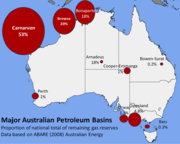
Western Australia
Western Australia is a state of Australia, occupying the entire western third of the Australian continent. It is bounded by the Indian Ocean to the north and west, the Great Australian Bight and Indian Ocean to the south, the Northern Territory to the north-east and South Australia to the south-east...
is the largest contributor to Australia's production of most petroleum products. Based largely on development of the reserves of the North West Shelf
North West Shelf
The North West Shelf of Western Australia is an extensive oil and gas region off the North West Australia coast in the Pilbara region.It has a considerable number of oil and gas wells, pipelines, production areas and support facilities.- Location :...
and other onshore hydrocarbon basins, the industry extracts crude oil, condensate
Natural gas condensate
Natural-gas condensate is a low-density mixture of hydrocarbon liquids that are present as gaseous components in the raw natural gas produced from many natural gas fields....
and natural gas
Natural gas
Natural gas is a naturally occurring gas mixture consisting primarily of methane, typically with 0–20% higher hydrocarbons . It is found associated with other hydrocarbon fuel, in coal beds, as methane clathrates, and is an important fuel source and a major feedstock for fertilizers.Most natural...
from petroleum reservoirs deep beneath the Earth's surface. A large plant located at Withnell Bay near Dampier
Dampier
Dampier may refer to:* Dampier, Western Australia* Division of Dampier, an Australian Electoral Division in Western Australia from 1913 to 1922* Dampier , English cricketer playing 1765-1787...
, produces liquefied natural gas
Liquefied natural gas
Liquefied natural gas or LNG is natural gas that has been converted temporarily to liquid form for ease of storage or transport....
(LNG) for export to Asian customers. Crude oil and most petroleum liquids are exported, and Australia's largest petroleum refinery at Kwinana
Kwinana
Kwinana may refer to:*Town of Kwinana, a Local Government Area in Western Australia*Kwinana Beach, Western Australia, a suburb in Western Australia*Kwinana Freeway, a major road in Western Australia...
in WA's south-west, produces petrol and diesel for local consumption. Natural gas is processed at plants located on islands off the WA coast and onshore, then transported by pipelines to gas users throughout the state.
In 2007, the industry produced 126 Moilbbl of crude oil/condensate, and 30 billion cubic metres of gas. 65% of the gas was transformed into 12 million tonnes of LNG (all of which was exported), with the remainder of the gas being sold to users in Western Australia. Primary production by the industry was valued at $16.7 billion, accounting for 31% of all natural resources produced in the state.
Early history
The earliest petroleum-related activity in the state was in 1902, with the first oil exploration well drilled near the Warren River area in the southwest. Traces of oil were found in a bore near Fitzroy Crossing in 1919. Formal exploration in Western Australia started in 1946, when the Australian Motorists Petrol Company (AMPOL) commenced an exploration programme, using the services of the Bureau of Mineral Resources (BMR) which had been set up by the Australian government in the same year to conduct survey work. In the following year, AMPOL were awarded the first two exploration permits in Western Australia near Exmouth.Large-scale surveys were conducted in the Canning Basin in 1947, and in the same year, Ampol
Ampol
Ampol, the Australian Motorists Petrol Company, was incorporated by Sir William Gaston Walkley in 1936 in New South Wales. This was in response to Australians' concerns about perceived inequitable petrol pricing, and allegations of transfer pricing by foreign oil companies to limit their tax...
secured exploration permits for the Exmouth region. Ampol formed a joint venture with Standard Oil of California. The new company was called West Australian Petroleum (WAPET)
WAPET
West Australian Petroleum Pty Ltd was a pioneer oil and gas exploration and processing company in Western Australia. Formed in March 1952 as a joint venture between Caltex and Ampol, the company discovered Australia's first flowing oil in November the following year, at Rough Range on the North...
, and drilled its first well at Rough Range in 1953. This well produced at a rate of 550 oilbbl/d, and was probably the commencement of Australia's commercial petroleum industry. In the following year, WAPET geologists conducted a basic survey of Barrow Island
Barrow Island
Barrow Island is the name of at least three islands:*Barrow Island *Barrow Island, Cumbria, England*Barrow Island...
. They were the first civilians to visit the area since British atomic testing on the nearby Monte Bello Islands. The company achieved major commercial success with a large discovery on the island in 1964, which was followed by a large scale operation which continues to this day.
In 1966, WAPET discovered WA's first commercial quantities of natural gas near Dongara. Construction of the state's first gas pipeline was completed in 1971. The pipeline transported gas from Dongara to Perth, Kwinana and Pinjarra. Originally known as the WANG Pipeline (after WA Natural Gas Pty Ltd which was a WAPET subsidiary), it is still in operation and now known as the Parmelia Pipeline. Woodside received its first permits to explore the Carnarvon basin in 1963. The 1971 gas/condensate discoveries by the BOCAL consortium at Scott Reef, North Rankin and Goodwyn were followed by a further gas/condensate discovery at Angel in 1972.
Geology
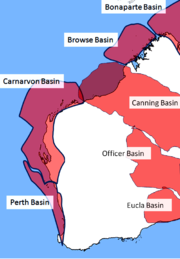
Carnarvon Basin
The Carnarvon Basin is a geological basin located in the north west of Western Australia. This is the main geological feature that makes up the North West Shelf...
, which stretches for 1,000 km of the west and northwest coast, from Geraldton to north of Port Hedland. In area, the onshore part of the Carnarvon Basin covers about 115,000 km² and the offshore part covers approximately 535,000 km² with water depths up to 3,500 m.
Less than 5% of the state's gas comes from fields near Dongara, part of the Perth basin, which extends about 1300 km along the southwestern margin of the continent. This is a large (172,300 km²) basin that formed during the separation of Australia and Greater India in the Permian to Early Cretaceous period. It includes a significant onshore component and extends offshore to the edge of continental crust in water depths of up to 4500 m.
The Officer basin, straddling the WA-SA border in the south-east section of the state, is a poorly explored basin, with limited seismic coverage, although more than 20 exploration wells have been drilled. A small amount of oil is produced in the Canning basin, in which 250 wells have been drilled and 78,000 line-km of 2D seismic surveys has been shot. A local company, Arc Energy, currently the largest Perth basin producer, is actively exploring and drilling in the Canning basin.
LNG
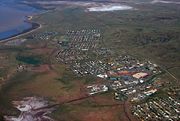
North West Shelf Venture
The North West Shelf Venture, situated in the north-west of Western Australia, is Australia's largest resource development project. It involves the extraction of petroleum at offshore production platforms, onshore processing and export of liquefied natural gas, and production of natural gas for...
(NWSV), a consortium of six energy companies led by Woodside, operates four LNG trains near Karratha. It relies on natural gas supplied from North Rankin, Goodwyn and Perseus fields in the Northwest Shelf (NWS). The majority of LNG produced by the NWSV is exported to Japan, with occasional spot sales to the United States, Spain and Korea. A fifth LNG train is currently under construction and is expected to increase export capacity by an additional 4.2 million tons, bringing total capacity to around 16 million tonnes per year. The cost of the project is estimated at $1.6 billion, with startup in late 2008.
Although the NWSV dominates Australia's LNG market, additional projects are in various stages of planning, the largest of which is the Gorgon gas project
Gorgon gas project
The Gorgon gas project is a natural gas project in Western Australia, involving the development of the Greater Gorgon gas fields, subsea gas-gathering infrastructure, and a liquefied natural gas plant on Barrow Island. The project also includes a domestic gas component...
. Chevron (along with joint venture partners Shell and ExxonMobil) is considering development of the Greater Gorgon gas fields, which contain recoverable reserves of 40 cubic foot (1.13267388E-08 km³). The project entails constructing subsea pipelines from the Gorgon and Jansz fields to Australia's Barrow Island
Barrow Island
Barrow Island is the name of at least three islands:*Barrow Island *Barrow Island, Cumbria, England*Barrow Island...
, where 3 liquefaction trains will produce 15 million tons of LNG per year.
Domestic gas
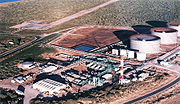
The state's two largest individual users of gas are Alcoa
Alcoa
Alcoa Inc. is the world's third largest producer of aluminum, behind Rio Tinto Alcan and Rusal. From its operational headquarters in Pittsburgh, Pennsylvania, Alcoa conducts operations in 31 countries...
(which operates three alumina refineries in the south-west) and Burrup Fertilisers (which operates the world's largest ammonia plant on the Burrup Peninsula, near Dampier). Together they account for more than half of the natural gas consumed in WA. Most of the remaining gas is used for electricity generation and by other smaller industrial and commercial users. Residential gas users consume only about 2% of the natural gas produced in the state.
There are three main 'supply lines' for WA's domestic gas:
- 65% From the North-West Shelf domestic gas plant near Dampier, operated by Woodside Petroleum, transporting gas via the Dampier to Bunbury Natural gas Pipeline (DBNGP);
- 30% From the Varanus Island facility operated by Apache Energy on behalf of a number of production joint ventures. Output from the Varanus Island plant is divided between mineral processing operations who receive their gas via the Goldfields Gas Pipeline, and industrial and commercial customers in Perth and the southwest who receive their supplies via the DBNGP which links with the Varanus Island trunk line about 130 km south of Dampier; and
- 5% From small gas producers near Dongara, transported via the Parmelia Pipeline.
Petroleum liquids (Crude oil, condensate and LPG)
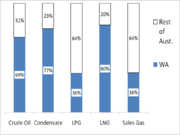
Western Australia is Australia's leading oil (and condensate) producing State, having surpassed Victoria, where production from the Gippsland Basin off the southern coast has been steadily declining. Western Australia currently produces 71% of Australia's crude oil and condensate. Australian crude oil and condensate production is projected to increase in the medium term (mainly due to new supply sources in Western Australia) before declining gradually.
Sector organisation
Similar to petroleum industries in other market-capitalist economies such as those in Western Europe and North America, the structure of the WA petroleum industry is characterised by the involvement of private corporations, with an important regulatory role occupied by the federalGovernment of Australia
The Commonwealth of Australia is a federal constitutional monarchy under a parliamentary democracy. The Commonwealth of Australia was formed in 1901 as a result of an agreement among six self-governing British colonies, which became the six states...
and state
Government of Western Australia
The formation of the Government of Western Australia is prescribed in its Constitution, which dates from 1890, although it has been amended many times since then...
governments in most aspects of the industry. Australian companies operating in the industry include Woodside Petroleum
Woodside Petroleum
Woodside Petroleum Limited is an Australian petroleum exploration and production company. It is a public company listed on the Australian Securities Exchange and has its headquarters in Perth, Western Australia.-History:...
, Santos
Santos Ltd.
Santos Ltd. is a large Australian oil and gas exploration company. Its name is an acronym for South Australia Northern Territory Oil Search.-Operations:...
and BHP Billiton
BHP Billiton
BHP Billiton is a global mining, oil and gas company headquartered in Melbourne, Australia and with a major management office in London, United Kingdom...
. Foreign-owned companies involved in the state include Apache Energy
Apache Corporation
Apache Corporation is an American independent oil and gas corporation. It is headquartered in 1 Post Oak Central in the Uptown district of Houston, Texas....
, BP
BP
BP p.l.c. is a global oil and gas company headquartered in London, United Kingdom. It is the third-largest energy company and fourth-largest company in the world measured by revenues and one of the six oil and gas "supermajors"...
, Chevron
Chevron Corporation
Chevron Corporation is an American multinational energy corporation headquartered in San Ramon, California, United States and active in more than 180 countries. It is engaged in every aspect of the oil, gas, and geothermal energy industries, including exploration and production; refining,...
, ExxonMobil
ExxonMobil
Exxon Mobil Corporation or ExxonMobil, is an American multinational oil and gas corporation. It is a direct descendant of John D. Rockefeller's Standard Oil company, and was formed on November 30, 1999, by the merger of Exxon and Mobil. Its headquarters are in Irving, Texas...
, Shell
Royal Dutch Shell
Royal Dutch Shell plc , commonly known as Shell, is a global oil and gas company headquartered in The Hague, Netherlands and with its registered office in London, United Kingdom. It is the fifth-largest company in the world according to a composite measure by Forbes magazine and one of the six...
, Inpex
Inpex
is a Japanese oil company established in 1966 as North Sumatra Offshore Petroleum Exploration Co., Ltd.In 2006, INPEX acquired Japanese oil company Teikoku Oil.- Projects :...
and ConocoPhillips
ConocoPhillips
ConocoPhillips Company is an American multinational energy corporation with its headquarters located in the Energy Corridor district of Houston, Texas in the United States...
.
Government
Government involvement in the industry covers areas such as policy development, safety and environmental regulation, investment facilitation, provision of infrastructure, releases of new exploration areas, acquisition of regional geological data. The legal framework within which petroleum exploration and development occurs is a result of the division of responsibilities between the Commonwealth and the states/territories under the Constitution and inter-governmental agreements (in particular, the 1978-79 OffshoreConstitutional Settlement).
Onshore, and out to 3 nm (nautical miles) from the territorial sea baseline (coastal waters), petroleum operations are the responsibility of the state government. WA's offshore areas beyond the 3 nm limit are governed by Commonwealth legislation (Offshore Petroleum Act 2005) administered by the Department of Innovation, Industry, Science and Research. The Law of the Sea Convention
United Nations Convention on the Law of the Sea
The United Nations Convention on the Law of the Sea , also called the Law of the Sea Convention or the Law of the Sea treaty, is the international agreement that resulted from the third United Nations Conference on the Law of the Sea , which took place from 1973 through 1982...
gives effect to a system of Exclusive Economic Zones under which nations have sovereign rights over natural resources out to 200 nm from the coast (Australia claimed such rights in 1994 under the Maritime Legislation Amendment Act 1994). The convention also allows Australia to claim sovereign rights over seabed resources where the continental shelf extends beyond 200 nm. State agencies also administer some aspects of federal petroleum-related legislation on behalf of the Commonwealth.
| Department / agency | Role |
|---|---|
| Department of Innovation, Industry, Science and Research | Advice and policy support regarding resources and energy |
| National Offshore Petroleum Safety Authority National Offshore Petroleum Safety Authority The National Offshore Petroleum Safety Authority is the occupational health and safety regulator for the Australian offshore petroleum industry... |
Administers offshore petroleum safety legislation |
| Foreign Investment Review Board | Approval of foreign investments >$100 m |
| Geoscience Australia | Research and advice to government and industry on petroleum prospects, reserves and potential |
| Department of the Environment, Water, Heritage and the Arts | Project assessment and approvals under the Environment Protection and Biodiversity Conservation Act 1999 (EPBC Act) |
| Department / agency | Role |
|---|---|
| Department of Mines and Petroleum Department of Mines and Petroleum The Department of Mines and Petroleum is a department of the Government of Western Australia. The department was formed on 1 January 2009, out of the former Department of Industry and Resources and Department of Consumer and Employment Protection, which were split into three new departments, the... |
Main state agency; facilitates state economic development and growth; exploration leases, production and pipeline licences |
| Economic Regulation Authority | Regulates monopoly aspects of the petroleum industry |
| Environmental Protection Authority | Advice to the Env. Minister; preparation of environmental protection policies; assessment of proposals and management plans |
| Office of Energy | Regulatory policy and structures for energy infrastructure |
Production facilities

Barrow Island
Barrow Island is the name of at least three islands:*Barrow Island *Barrow Island, Cumbria, England*Barrow Island...
where commercial oil production in WA commenced in 1964. WA's largest production platforms are North Rankin A and Goodwyn A - both operated by Woodside Petroleum
Woodside Petroleum
Woodside Petroleum Limited is an Australian petroleum exploration and production company. It is a public company listed on the Australian Securities Exchange and has its headquarters in Perth, Western Australia.-History:...
- located approximately 130 km west of Dampier, where the ocean depth is about 100 m.
Transportation
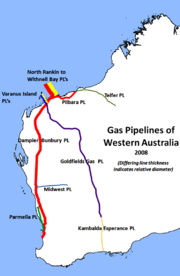
- Dampier to Bunbury Natural Gas PipelineDampier to Bunbury Natural Gas PipelineThe Dampier to Bunbury Natural Gas Pipeline is the longest natural gas pipeline in Australia. It is 660mm in diameter, which also makes it one of Australia's largest in terms of transmission capacity...
(DBNGP), which transports gas from the North West Shelf area to customers in the Geraldton, Perth, Mandurah and Bunbury areas; - Goldfields Gas Pipeline (GGP), taking gas from Varanus IslandVaranus IslandVaranus Island is the largest of the Lowendal Islands, an archipelago off the north west coast of Western Australia, near Karratha in the Pilbara region...
to the Goldfields; - Parmelia Pipeline, taking gas from various fields in the Perth Basin to customers in the State's South West; and
- Pilbara Energy Pipeline - from Dampier to Port Hedland.
Refining
Refining refers to the transformation of crude oil and condensate into end-use petroleum products. The state's only oil refinery, owned and operated by BPBP
BP p.l.c. is a global oil and gas company headquartered in London, United Kingdom. It is the third-largest energy company and fourth-largest company in the world measured by revenues and one of the six oil and gas "supermajors"...
, is located at Kwinana
Kwinana
Kwinana may refer to:*Town of Kwinana, a Local Government Area in Western Australia*Kwinana Beach, Western Australia, a suburb in Western Australia*Kwinana Freeway, a major road in Western Australia...
, and was commissioned in 1955. With a production capacity of 132050 oilbbl/d, it is the largest of Australia's seven refineries, accounting for almost 20% of national refining capacity. As most of the crude oil and condensate produced in WA is exported to Asia by ship
Oil tanker
An oil tanker, also known as a petroleum tanker, is a merchant ship designed for the bulk transport of oil. There are two basic types of oil tankers: the crude tanker and the product tanker. Crude tankers move large quantities of unrefined crude oil from its point of extraction to refineries...
, the Kwinana refinery relies mainly on shipments of crude oil from elsewhere in Australia and overseas. For many years, a small amount of crude oil has arrived for processing at the refinery via road tanker, having been produced at onshore wells near Dongara since the late 1960s.
The quantity of Perth basin oil production rose substantially in 2001 when the Cliff Head field (10 km off the coast near Dongara in 15 m of water) was brought into production., about 320 km north of Perth
Perth, Western Australia
Perth is the capital and largest city of the Australian state of Western Australia and the fourth most populous city in Australia. The Perth metropolitan area has an estimated population of almost 1,700,000....
. The refinery mostly produces petrol and diesel, along with jet fuel, bitumen and liquid petroleum gas (LPG). Australia's refineries have experienced declining gross margins for several years, mainly due to competition from foreign refineries, an oversupply of refining capacity in Asia, and the high cost of transporting crude oil to Australia.
Supply disruption
The state's heavy reliance on gas from the north west has become a prominent public issue on several occasions when disruptions to supply has occurred. On 18 February 2004, Western PowerWestern Power
Western Power Corporation , owned by the Government of Western Australia, was Western Australia's major electricity supplier from 1995 through 2006...
(electricity provider) imposed compulsory restrictions on power usage in Perth. This occurred on a day when the temperature was expected to reach nearly 42°C and the company was unable to use its 'peakload' gas-fired power stations because of maintenance being carried out on the main pipeline
Dampier to Bunbury Natural Gas Pipeline
The Dampier to Bunbury Natural Gas Pipeline is the longest natural gas pipeline in Australia. It is 660mm in diameter, which also makes it one of Australia's largest in terms of transmission capacity...
from the north-west.
On 2 January 2008, an electrical fault resulted in a production shutdown at the North West Shelf Venture's Karratha Gas Plant. Production resumed on 4 January and normal gas supplies was re-established by 6 January 2008. It was a complete shutdown affecting both LNG exports and domestic gas production. Domestic gas supplies were cut by 2/3.
The most serious and significant disruption occurred in June 2008, when a pipeline rupture and explosion at the Varanus Island facility caused a 3-month shutdown of the plant, reducing the state's supply of natural gas by one-third.
Domestic gas reservation policy
In 2006, the state government announced a policy requiring that future developers of export gas projects set aside 15% of the reserves in each gas field for domestic use within the state. This policy replicated the initial State Agreement for the North West Shelf Project, and was based on a perceived decline in the availability of gas from non-export developments. For developers of large export projects, LNG exports generally offer higher returns than sales of gas into the domestic market. A federal parliamentary report referred to the state policy, stating that "while Western Australia presently consumes about 35% of Australia's domestic gas use, and the bulk of LNG exports, there is still a very healthy reserves-to-production ratioReserves-to-production ratio
The Reserves-to-production ratio is the remaining amount of a non-renewable resource, expressed in years. While applicable to all natural resources, the RPR is most commonly applied to fossil fuels, particularly petroleum and natural gas...
in excess of 100 years.
Garnaut Climate Change Review
Australia's ratification of the Kyoto Protocol treaty in March 2008 is likely to increase the country's use of natural gas to displace more carbon-dioxide-intensive coal. The first draft report of the Garnaut Climate Change ReviewGarnaut Climate Change Review
The Garnaut Climate Change Review was a study by Professor Ross Garnaut, commissioned by then Opposition Leader, Kevin Rudd and by the Australian State and Territory Governments on 30 April 2007...
(released on 4 July 2008), which identified the impacts of climate change on Australia and proposed numerous public policy measures designed to mitigate these effects, may have a significant impact on aspects of the industry. Among the measures proposed was an emissions trading scheme "which will make higher-emissions forms of energy generation more expensive, shifting demand towards lower-emissions sources, and towards technologies that capture and sequester emissions...and in transport, an emissions trading scheme will make higher-emissions forms of transport more expensive, shifting demand to lower-emissions forms"

